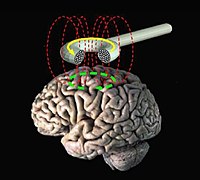
Photo from wikipedia
Introduction The negative motor area (NMA) is defined as a cortical area where 50 Hz electrical cortical stimulation produces inhibition of the voluntary movement such as finger tapping. The function of… Click to show full abstract
Introduction The negative motor area (NMA) is defined as a cortical area where 50 Hz electrical cortical stimulation produces inhibition of the voluntary movement such as finger tapping. The function of NMA has not been well delineated since previous 50 Hz stimulation studies mainly focused on the all or none response, namely, arrest of finger tapping at high current intensity. We hypothesized that NMA plays a role in higher motor behavior such as praxic movements. Our objective was to clarify the praxis-related function of NMA by applying stimulation at smaller intensity to evaluate the effect of stimulation. Methods Subjects were 5 patients with intractable focal epilepsy who underwent implantation of intracranial electrodes in the inferior frontal area for presurgical evaluation (IRB#C1062). After defining NMA with 50 Hz stimulation at high intensity for clinical purpose, stimulation was delivered at the intensity 1–3 mA smaller than that of clinical mapping in the following tasks: finger tapping, reach-to-grasp task, imitation of meaningless finger gesture, and pantomime of tool-use. The stroke of finger tapping, and the maximum aperture and reaching velocity in reach-to-grasp tasks are evaluated quantitatively with 3D motion capture system. Finger gesture and tool-use pantomime were evaluated qualitatively because of technical difficulty in applying the motion capture system. Results NMA was identified in the precentral gyrus in 3 patients, the ventral premotor area in 1 and at their border in 1. In 3 patients with precentral NMA, quantitative analysis revealed the significant decrease of stroke in finger tapping and maximum aperture in grasping, while the reaching velocity did not change significantly. Qualitative analysis showed mild slowing of finger gesture in 1 out of 3 patients but did not change the performance of tool-use pantomime. In the more rostral NMA (in the ventral premotor area and at the border), quantitative analysis also showed the significant decrease of stroke and aperture in finger tapping and grasping, respectively. In addition, reaching velocity was significantly decreased. Qualitative analysis showed either mild slowing (at the border) or arrest of finger gesture (ventral premotor area), and arrest of tool-use pantomime in 1 out of 2 patients (ventral premotor area). Conclusion Precentral NMA seems to play a more role in controlling elementary finger movements than praxic movements, and, when impaired, could be responsible for limb-kinetic apraxia. More rostral NMA is likely associated with more complex movements. These findings suggested functional subdivisions within NMA and may help understand the disability after focal resection of NMA.
Journal Title: Clinical Neurophysiology
Year Published: 2018
Link to full text (if available)
Share on Social Media: Sign Up to like & get
recommendations!